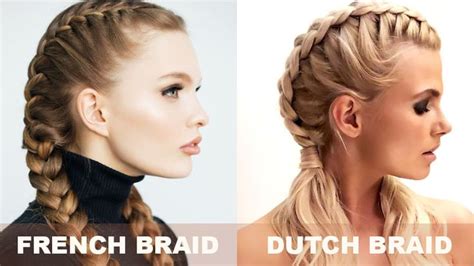In the enchanting world of hair styling, two braiding techniques stand tall as the most coveted: Dutch braids and French braids. Each boasts unique characteristics that appeal to different tastes and hair types. This comprehensive guide will delve into the depths of these braiding wonders, comparing and contrasting their techniques, advantages, disadvantages, and applications, empowering you to make an informed choice that perfectly suits your hair aspirations.

Table 1: Dutch vs. French Braids: Key Differences
| Feature | Dutch Braid | French Braid |
|---|---|---|
| Origin | Netherlands | France |
| Placement | Starts from the nape of the neck | Starts from the crown of the head |
| Weaving Direction | Hair is woven under | Hair is woven over |
| Result | Thick, raised braid | Flatter, intricate braid |
Advantages of Dutch Braids
- Volume and Height: Dutch braids create a voluminous and elevated effect, perfect for adding height and dimension to fine or flat hair.
- Versatile Styling: They offer a range of styling options, such as buns, ponytails, and half-updos, enhancing the versatility of your hairstyles.
- Long-Lasting Hold: Dutch braids are known for their secure hold, making them ideal for active lifestyles or special occasions where durability is crucial.
Disadvantages of Dutch Braids
- Painful for Some: The tight weaving of Dutch braids can cause discomfort or pain for people with sensitive scalps.
- Time-Consuming: They require more time and effort to create compared to French braids.
- Not Suitable for Loose Hair: Dutch braids are not recommended for people with loose or slippery hair, as the strands may slip out easily.
Advantages of French Braids
- Painless and Comfortable: French braids are less painful and more comfortable to wear, making them suitable for all scalp types.
- Quick and Easy: They are relatively easy to learn and can be created in a shorter amount of time compared to Dutch braids.
- Versatile and Intricate: They offer a wide variety of intricate designs and variations, inspiring endless styling possibilities.
Disadvantages of French Braids
- Flatter Appearance: French braids result in a flatter and less voluminous braid, which may not be ideal for people seeking a more lifted look.
- Less Secure Hold: They tend to have a looser hold than Dutch braids, making them less suitable for vigorous activities or long-term wear.
Applications
Dutch Braids
- Formal Events: Dutch braids add a sophisticated touch to formal hairstyles, such as buns and chignons, for weddings, proms, and other special occasions.
- Sporting Activities: Their secure hold makes them ideal for athletes engaging in sports that require constant movement, such as running, cycling, or tennis.
- Thick and Curly Hair: Dutch braids are a great choice for people with thick or curly hair, as they can tame unruly strands and create a polished look.
French Braids
- Casual Style: French braids are perfect for everyday wear, adding a touch of elegance to simple outfits and creating a laid-back yet chic look.
- Braided Headbands: They can be used to create stylish braided headbands that frame the face and enhance any hairstyle.
- Fine and Straight Hair: French braids work well for people with fine or straight hair, as they can add texture and volume while maintaining a smooth and sleek appearance.
How to Braid: Dutch vs. French
Dutch Braid
- Divide your hair into three equal sections at the nape of your neck.
- Cross the right section over the middle section.
- Take a small section of hair from the left side and add it to the right section.
- Cross the new right section over the middle section.
- Repeat steps 3-4 on the left side, adding hair from the right side.
- Continue braiding in this manner until you reach the crown of your head.
- Finish with a traditional three-strand braid.
French Braid
- Take a small section of hair from the crown of your head and divide it into three equal strands.
- Cross the right strand over the middle strand.
- Pick up a small section of hair from the right side of your head and add it to the right strand.
- Cross the new right strand over the middle strand.
- Repeat steps 3-4 on the left side, adding hair from the left side.
- Continue braiding in this manner until you reach the base of your neck.
- Finish with a simple three-strand braid.
Creative Applications of Dutch and French Braids
Double Dutch Braid Bun: Create two Dutch braids on either side of your head and secure them into a messy bun at the nape of your neck.
French Braid Crown: Braid a French braid around the circumference of your head to create a beautiful and intricate crown.
Braided Ponytail: Dutch or French braid your hair into a ponytail for a stylish and functional hairstyle.
Braided Bangs: Create a Dutch or French braid with your bangs and pin it back for a fresh and flattering look.
Conclusion
The choice between Dutch braids and French braids depends on your individual preferences, pain tolerance, hair type, and desired result. Dutch braids offer volume, height, and long-lasting hold, making them ideal for special occasions and active lifestyles. French braids provide a flatter, more intricate braid that is less painful and easier to create, perfect for everyday wear and delicate scalps. By understanding the unique characteristics of each technique, you can harness their braiding magic to transform your hair into a masterpiece of style and sophistication.
